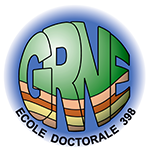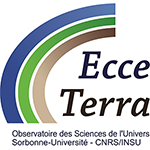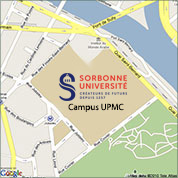Séminaire ISTeP - Matthias Delescluse
(ENS Paris)
The oceanic crustal structure at the extinct, slow to ultra-slow Labrador Sea spreading center
Two seismic refraction lines were acquired along and across the extinct Labrador Sea spreading center during the SIGNAL 2009 cruise. We derived two P-wave velocity models using both forward modeling (RAYINVR) and travel time tomography inversion (TOMO2D) with good ray coverage down to the mantle. Slow spreading Paleocene oceanic crust has a thickness of 5 km, while the Eocene crust created by ultra-slow spreading is as thin as 3.5 km. The upper crustal velocity is affected by fracturation due to a dominant tectonic extension during the waning stage of spreading, with a velocity drop of 0.5 to 1 km/s when compared to Paleocene upper crustal velocities (5.2-6.0 km/s). The overall crustal structure is similar to active ultra-slow spreading centers like the Mohns Ridge or the South West Indian Ridge (SWIR) with lower crustal velocities of 6.0-7.0 km/s. An oceanic core complex is imaged on a 50 km-long-segment of the ridge perpendicular line with serpentinized peridotites (7.3-8.0 km/s) found 1.5 km below the basement. The second, ridge-parallel line also shows extremely thin crust in the extinct axial valley, where 8 km/s mantle is imaged just 1.5 km below the basement. This thin crust is interpreted as crust formed by ultra-slow spreading, which was thinned by tectonic extension after cessation of spreading. We compare these results with other cases of ridge extinctions (Baffin Bay, Shikoku Basin, South China Sea) to discuss the roles of melt supply and far field kinematics in the processes leading to the cessation of spreading.
05/12/2014 à 12h30, Salle Fourcade (Tour 55/56, 4ème étage)
Egalement dans la rubrique
- Séminaire ISTeP - Chrystèle Sanloup
- Séminaire ISTeP - Marco Scambelluri
- Séminaire ISTeP - Déborah Chavrit
- Séminaire ISTeP - Evgueni Burov
- Séminaire ISTeP - Anne Le Friant
- Séminaire ISTeP - Pierre Valla
- Séminaire ISTeP - Ramadan Ghalayini
- Séminaire ISTeP - Séverine Moune
- Séminaire ISTeP - Lucie Tajcmanova
- Séminaire ISTeP - Gabriel Coelho
- Séminaire ISTeP - Laurie Bougeois
- Séminaire ISTeP - Jacques Touret
- Séminaire ISTeP - Sanae El Janyani
- Séminaire ISTeP - Arthur Paté
- Séminaire ISTeP - Nicolas Beaudoin
- Séminaire ISTeP - Kosuke Ueda
- Séminaire ISTeP - Ali Hannouche
- Séminaire ISTeP - Benjamin Cochain
- Séminaire ISTeP - Behzad Nasri
- Séminaire ISTeP - Daniel Pastor Galan
- Séminaire ISTeP - Sara Lafuerza Colas
- Séminaire ISTeP - Jean-Pierre Suc
- Séminaire ISTeP - Pierpaolo Zuddas
- Séminaire ISTeP - Agnès Elmaleh
- Séminaire ISTeP - John Wakabayashi
- Séminaire ISTeP - Jonas Ruh
- Séminaire ISTeP - Timm John
Chiffres clés (Mars 2025)
L'ISTeP comprend 131 membres dont :
Permanents (66)
- Professeurs : 17 (+2 PAST)
- Maîtres de conférence : 26
- Directeurs de recherche CNRS : 1
- Chargés de recherche CNRS : 1
- ITA : 19
Personnels non permanents (65)
- Collaborateurs bénévoles / émérites : 17
- Chaire de professeur junior : 1
- Enseignants-chercheurs contractuel : 2
- 1 MCF accueil en délégation
- ATER et Post-Docs : 9
- Doctorants : 32
- ITA-BIATSS : 3





